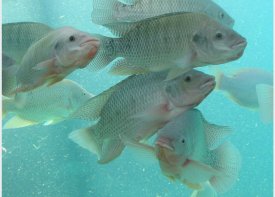
Lessons in Aquaponics: Fish Care and Maintenance
If you are familiar with aquaponics, then chances are that you are aware of the importance of maintaining healthy fish. In an aquaponic garden, fish play a vital role in maintaining the balance of the system and providing essential nutrients for the plants to grow. That being stated, AquaGrove often receives questions about fish care, and many educators inquire about the best methods for providing lessons and information on fish and their role in aquaponics.
The truth is that keeping things as simple as possible, both for students and new growers, is the best course of action. While aquaponics can seem overwhelming for a newcomer, once you have the basics, it is all about maintaining a balance that works for your system and garden.
Let’s first address fish types and pH. As explored in our previous post “Lessons in Aquaponics: pH and Plants”, the ideal pH level in aquaponics is within the range of 6.8-7.0. Due to the fact that fish originate from various bodies of water (ponds, rivers, streams, lakes, oceans), they all respond differently to various pH levels and have different needs. For example, saltwater fish prefer an alkaline pH of 8.0 or above, while freshwater fish thrive in a lower range, somewhere between 5.5 and 7.5, depending on the specific species.
For educators, a great resource for students to learn more about pH, water quality and testing can be found through USGS; their website includes an easy-to-understand pH table and important information provided by the Water Science School.
When it comes to AquaGrove, Tilapia is often the fish of choice (especially for beginners), due to its hardiness and ability to adapt to fluctuations in pH and conditions. Tilapia is the most widely grown of any farmed fish. As a tilapia grower, you can expect a thriving aquarium. Adult female tilapia spawn every 4-6 weeks, and just one female will typically produce about 200-1000 eggs per spawn. They thrive in water temperatures between 60-80 degrees Fahrenheit; as they prefer the higher end of the temperature scale, the thermal technology offered by AquaGrove’s tank assists with managing and maintaining appropriate water temperature year-round.
Overall, tilapia is easy to breed, and they grow to maturity faster than most other cultured fish, potentially growing to 2.5 lbs. in seven months. As previously noted, they are known for their resilience and hardiness, making them ideal for an aquaponics system.
Fish care is key to a healthy aquaponic garden. If the fish are not healthy, the system will simply not function properly or produce a successful harvest. Just like any living creatures, fish require daily feedings, monitoring of growth and proper care. At the same time, their environment (water), must maintain the proper temperature and balance to ensure their health.
A solid source of information regarding fish care and aquaponics maintenance is Texas A&M. In 2013 they published a journal on “Aquaponics – Growing Fish and Plants Together”. In the publication they highlighted some key areas and tips for maintaining fish health which include the following points:
- pH – Most fish like pH between 6-8
- Ammonia and nitrites are very toxic to fish.
- Nitrates are fairly safe for fish (and great for plants).
- Fish need oxygen; they can die in 30 minutes without it. Battery based aerators are available for power outages, as well as back-up batteries for the entire system.
- Drastic temperature changes can cause health issues and death.
- Fish can be sensitive to light (avoid direct light).
- Do not exceed temperature changes of more than 3 degrees Fahrenheit per day if possible.
- Fish cannot regulate their body temperature like humans do, and they are dependent on the water temperature for their body temperature.
To read more about water quality and how it relates to fish care in aquaponics, check out “Water Quality in Aquaponics” by Texas A&M AgriLife Extension. To find out how you can begin your own aquaponics program and garden, contact AquaGrove.
